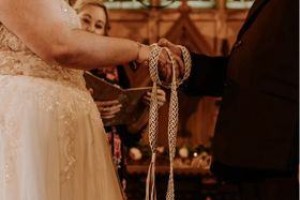Find a Celebrant Now
Embracing tradition: The History and Significance of Handfasting in Wedding Ceremonies

Embracing tradition: The History and Significance of Handfasting in Wedding Ceremonies
Couples often seek meaningful rituals and traditions to incorporate into their special day and one of those rituals that has seen a resurgence in popularity in recent years is handfasting.
Originating from ancient Celtic traditions, handfasting is a symbolic gesture of unity and commitment that holds deep historical and cultural significance. Here are some reasons why couples might choose to include this timeless ritual in their wedding ceremony.
The Origins of Handfasting
Handfasting traces its roots back to ancient Celtic and Norse cultures, where it served as a symbolic way for couples to declare their commitment to one another. In Celtic tradition, handfasting was a legal and binding betrothal ceremony that preceded the formal wedding. Couples would join hands and have their hands bound together with cords or ribbons, symbolising their union and commitment to each other for a specified period, often a year and a day.
The Symbolism of Handfasting
At its core, handfasting symbolises the binding together of two individuals in love and partnership. The act of joining hands represents the coming together of the couple's lives and the creation of a shared future. The cords or ribbons used in the ceremony are often chosen for their significance, with each colour representing different aspects such as love, trust, unity, and fidelity.
Reasons to Include Handfasting in Your Wedding Ceremony
- Honouring Heritage and Tradition: For couples with Celtic or Norse ancestry, incorporating handfasting into their wedding ceremony is a meaningful way to honour their heritage and connect with ancient traditions passed down through generations.
- Symbol of Unity: Handfasting serves as a powerful symbol of unity and commitment, signifying the couple's intention to embark on life's journey together, supporting and loving each other through all the highs and lows.
- Personalisation: One of the beautiful aspects of handfasting is its versatility and adaptability. Couples can customise the ceremony to reflect their unique love story, choosing cords or ribbons that hold personal significance and weaving in vows or blessings that resonate with them.
- Spiritual Connection: Handfasting can also hold spiritual significance for couples who wish to infuse their wedding ceremony with elements of spirituality or symbolism. Whether rooted in Celtic paganism, Wiccan traditions, or simply a reverence for nature, handfasting offers a sacred moment of connection and reflection.
- Community Involvement: Handfasting provides an opportunity to involve loved ones in the wedding ceremony. Family members or friends can be invited to assist in tying the cords or ribbons, symbolising their support and blessing for the couple's union.
- Renewal of Vows: For couples who are already married, handfasting can serve as a beautiful way to renew their vows and reaffirm their commitment to each other. It offers a chance to pause, reflect, and celebrate their enduring love and partnership.
